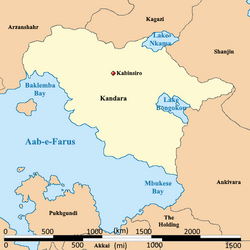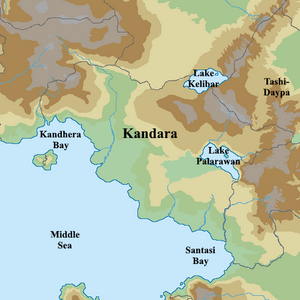Kandara
| This article is a stub. You can help IxWiki by expanding it. |
Sovereign and Independent People's Republic of Kandara Kandhera | |
|---|---|
 Location of Kandara | |
| Capital | Kabinsiro |
| Largest city | Port of Bomonba |
| Official languages | Kandaro, Burgoignesc language |
| Ethnic groups | Primarily Kandi |
| Religion | Shia Islam, or Mercantile Reform Protestantism in a 60/40 split |
| Demonym(s) | Kandari (noun) Kandaran (adjective) |
| Government | Kraterocracy |
• Admiral-General | Stephan Mojalefa |
| Establishment | |
| 1795 | |
| Area | |
• | 1,515,583.34 km2 (585,170.00 sq mi) |
| Population | |
• Estimate | 18,476,480 |
• Density | 12.191/km2 (31.6/sq mi) |
| GDP (nominal) | estimate |
• Total | $32,389,269,440 |
• Per capita | $1,753 |
| Currency | Common Middle Sea Florin (CMS ƒ) |
Kandara, officially the Sovereign and Independent People's Republic of Kandara, is categorized as a least developed country nation in central Audonia. It is bound by the Aab-e-Farus in the east, Arzanshahr in the northwest, Kagazi in the north, and Shanjin and Ankivara in the east. It is known as the world's only kraterocracy run by a violent military regime led by Admiral-General Stephan Mojalefa.
It is a member of the League of Nations, the International Red Cross and Red Crescent Movement, and many other international organizations, but is not an active participant, rather an aide recipient.
It is a command economy focused on raw resource extraction and export, under the watchful eye of Burgundie whose companies have a massive stake in the country's economic activity. Despite its status as a failed state, it is an active member in the Middle seas region's economic activity due primarily to the sheer size of its mineral wealth.
Many scholars have criticized its economic governance and politics, arguing that it is merely a client of the Burgoignesc thalattocracy's economic and cultural might.
The people of Kandara are predominantly culturally Kandi, speak Kandaro, and most practice Shia Islam, or Mercantile Reform Protestantism in a 60/40 split.
Government and politics
Administrative divisions and municipalities
Demographics
-
A big ole' Kandaran baby
Culture
La Sape
Further: La Sape
Kings, just kings for days.
Geography

-
Kandaran coast
-
Kandaran coastal plain
-
Farming in the interior
-
Kandaran highlands
-
Fishing village
-
"The Scrub" of the coastal plains
Kinkasendjo mountains
Climate
Because of its location, at the eastern end of the tradewinds, Kandara is exceptionally arid. Any moisture from the interior plains of the Dolong region of Audonia catching in the Kinkasendjo mountains before it reaches the Kandara coastal plains.
Military
Army of Kandara
Traditional state military with traditional weapons and equipment contracts with respected overseas countries, namely Burgundie, Urcea, and Yonderre. Mixed of mechanized and unmechanized forces with some air support. Fully logistically supplied by the state.
Kando Lalrissian's Army of God
Religiously-based militia, numbering around 5,000 soldiers, supported by proxy from large external states using intermediary buyers.
People's Liberation Army of Gabo
Regional socialist independence army for the region of Gabo. There are around 7,000 soldiers almost entirely mechanized in technicals.
General Fully Clothed's Janjaweed
Cult of personality around General Fully Clothed (ne Mbiybe Teh). numbering around 450 soldiers, based on the season.
Loko Haram
Anti-occidental, Burgophobia Islamist militia, numbering around 2,500. Mix of partisan irregular infantry and technical-mounted attack squads
Economy
Infrastructure
Roads and rail
Louage
A louage is a minibus shared taxi in many parts of Daria that were colonized by Burgundie. In Burgoignesc, the name means "rental." Departing only when filled with passengers not at specific times, they can be hired at stations. Louage ply set routes, and fares are set by the government. In contrast to other share taxis in Audonia, louage are sparsely decorated. Louages use a color-coding system to show customers what type of transport they provide and the destination of the vehicle. Louages with red lettering travel from one state to another, blue travel from city to city within a state, and yellow serves rural locales. Fares are purchased from ticket agents who walk throughout the louage stations or stands. Typical vehicles include: the MILCAR Jornalero, the TerreRaubeuer Valliant 130, and the CTC M237-07.


































